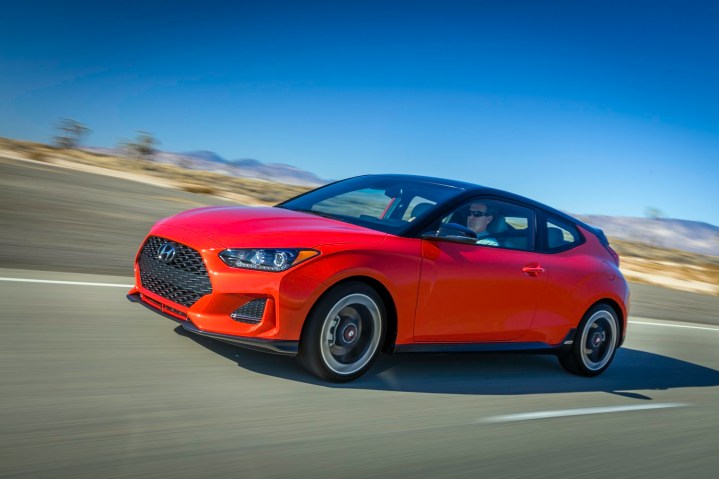 The 2019 Hyundai Veloster sports a new face and more power in the form of an optional turbocharged engine, adding to the quirky hatchback’s appeal. Newly-released pricing information for the 2019 Veloster shows Hyundai hasn’t lost its ability to deliver a good value, either.
The 2019 Hyundai Veloster sports a new face and more power in the form of an optional turbocharged engine, adding to the quirky hatchback’s appeal. Newly-released pricing information for the 2019 Veloster shows Hyundai hasn’t lost its ability to deliver a good value, either.
When it hits U.S. showrooms later this year, the Veloster will start at $18,500, although a mandatory $885 freight charge (included in all prices listed here) bumps that price to $19,385. That buys a base model with a six-speed manual transmission and 2.0-liter four-cylinder engine, which produces a healthy 147 horsepower and 132 pound-feet of torque. Standard equipment includes LED daytime running lights, lane keep assist, and a 7.0-inch touchscreen infotainment system with Apple CarPlay and Android Auto.
Hyundai also offers a six-speed automatic transmission, which is a $1,000 option. Automatic models can be equipped with a Premium Package that adds blind-spot monitoring, automatic climate control, heated seats, eight-speaker Infinity audio system, and an 8.0-inch touchscreen display. That bumps the price up to $23,635.
Buyers looking for more power can step up to the 1.6-liter turbocharged four-cylinder engine, which produces 201 hp and 195 lb-ft of torque (202 lb-ft on overboost). This engine can be paired with the manual transmission in the Veloster Turbo R-Spec model for $23,785, or a seven-speed dual-clutch transmission in the Veloster Turbo for $26,285.
The Turbo R-Spec also adds model-specific interior and exterior trim, a system that pipes fake engine noises into the cabin, and sport-tuned suspension. The Veloster Turbo adds back the heated seats and automatic climate control, which aren’t available on the R-Spec.
Hyundai also offers a range-topping Turbo Ultimate model, which includes the turbocharged engine and additional features like leather seats, wireless phone charging, navigation, adaptive cruise control (on dual-clutch models only) and a head-up display. The Turbo Ultimate starts at $27,535 with the manual transmission, and $29,035 with the dual-clutch gearbox.
Missing from the pricing announcement is any information on the Veloster N, a hot-rod version from Hyundai’s new N sub-brand with a 2.0-liter turbocharged four-cylinder engine producing 275 hp and 260 lb-ft. The N will likely hit U.S. dealerships sometime after the other Veloster variants, which will go on sale here within the next few months.


